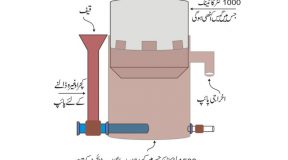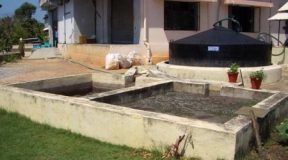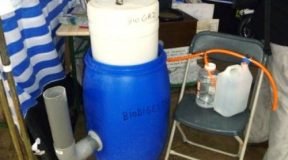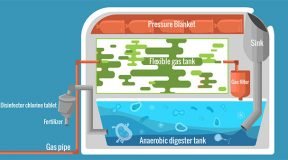Construction of Portable Biogas Digester Here is the description of the system, the basic principles are very simple, use the things you find in your surroundings.
| 1. Cut the top off at a 2.500 liter water tank.You have now made the stomach of your “sacred cow”. |
| 2. Drill 2” hole at bottom of tank and 1” hole at top of tank. |
| Put tank adaptors in holes (threaded pipewith rubber gasket and locking nut, sometimes called bulkhead fittings (check aquarium shop).
|
| 4. Fit 1” pipe in top hole (pic 4.a) on outside and 2” pipe inside tank that reaches to middle of tank. Fit 2” tube outside tank to elbow going into tank. This is your feeding tube or the “throat of the cow” (pic 4.b-c). |
| biogas digester |
5. Gas Collector. Take another tank that is smaller in diameter than the “stomach” tank you made (one that fits inside) but try to get one as close to the first tank as possible (for a 2.500 “stomach” tank you may only be able to find a 2.000 l “gas collector” tank. Cut holes in the bottom of this tank as shown (pic 5).
| 6. Cut 8 holes slightly larger than 2” in bottom. |
| 7. Burn or drill a ½” hole in the top of the gas collector tank near the side as shown. |
| Put a ½” tank fitting in this hole |
9. Put small stones at bottom of stomach tank as homes for bacteria, but do not block or go higher than the output of the feeding pipe.
10. Fill with about 300 to 500 liters of water (grey water is fine).Then pour in about 100 kg of animal manure (this keeps the manure from being exposed to too much oxygen.If you put manure in first you aerate it as you add water and that can kill bacteria. Bu sure and use fresh moist or wet fermented manure). Fill the stomach tank to the top until some drips out the 1” pipe.
11. Cut 8 2” pipes slightly shorter than the height of the gas collector and cut holes in them like a church organ to let food in and gas out.
| 12. Fix a piece of ½” pipe (A) through one end of the 2” pipe and melt its ends so it flares out and can´t fall out of the 2” pipe. |
| 13. Put the 2” pipe in the larger than 2” hole in the gas collector and when it is inserted, fix a ½” pipe (B) in the other end and flare it. Nowthe 2” pipe can’t fall out of the tank when it goes up and down. Do the same thing for the other 7 pipes. These are our “bacterial motels” or bacterial fuel rods! |
| Add caption |
| 14. Place the gas collector in the stomach tank. Let it sink down until completely submerged if possible, making sure that the bacteria hotels are straight up and down (you may need to turn the tank slowly as you put it in and let the air out”. |
15. Put an elbow, ½” valve and hose adaptor on the ½” tank adaptor and connect to ½” plastic tube.
16. Wait 3 weeks or so with valve closed until gas collector starts to rise. Release all gas to air and let it rise again. Release all gas in case it has oxygen in it.
17. The third time tank rises, try to light gas coming out. If it doesn’t light it has too much CO
2in it. Release it and let it rise again. One day it will light as CH2concentration rises.once it lights you can start slowly feeding.
18. When you connect the outcoming gas tube with your cooking place, make sure that a simple “water trap” is included, so that the pipes do not become blocked by condensing water.
download diagram |
Biogas Pipeline Connection fittings
Biogas naturally contains water vapor.When it flows through a pipe, some of the vapor condenses as liquid water, and if it is left in the pipe, it will eventually collect and block the gas flow.The solution is a water trap, a simple device which allows the water to escape. It should be fitted to biogas pipes wherever there is a local low point of the pipe where water naturally collects. And pipes should be laid so that these low points are at easily accessible positions. The water trap consists of a T-joint running a short tube down from the main tube into a small container full of water. The pressure of the water prevents gas from escaping. The water level should be approximately 15cm (equivalent to 150 mbar) to ensure no gas loss. The container could be a plastic water bottle for example. As it fills with water it will slowly overflow, so the location should be one where a small amount of water leakage is okay. An inspection hole in the ground, for example, works well. Pipeline Connection
| Ideal pipe fitting |
| bad pipe fitting |
Parts of the bio gas digester:
inlet (mixing chamber) for cattle dung fed plant,digester (digestion chamber), gas holder (storage chamber), outlet (displacement chamber), gas conveyance system and slurry compost pit(s). The mix of dung and water (mixed in inlet or mixing chamber) passes through the inlet pipe to the digester. The mixer produces gas through digestion process in the digester and the produced gas is stored in the gas holder (top of dome). The digested slurry passes out from digester to outlet tank (displacement chamber)
1. Inlet (Mixing Tank)
2. Inlet Pipe(s)
3. Digester
4. Gas Holder (dome)
5. Manhole
6. Outlet
7. Main Gas Pipe and Turret
8. Main Gas Valve
9. Pipeline
10. Water Outlet (Water Trap or Drain)
11. Pressure Gauge
12. Gas Tap
13. Gas Stove with rubber hose pipe
14. Gas Lamp (Optional)
15. Slurry pit(s)
Sea Also
- DIY biogas plant
- Biogas in Urdu
- Biogas Digester Photos
- Biogas Plant Photos from PDBP
- Small scale kitchen waste biogas plant
- Biogas In Pakistan - Pakistan Science Club
-
How To Bio Gas Plant Works
-
Biogas Plant Pakistan Science Club
-
gobar Gas plant in pakistan ...
-
Biogas Digester Photos







3 Comments
malawianboi
(January 20, 2018 - 2:46 am)You guys are awesome! Thank you for such thoughtful and we’ll laid out plans. Can I please get a personal email address so that I can contact u later?
Thanks again and God bless you!
Abdul Rauf
(January 20, 2018 - 5:48 am)please check you email
malawianboi
(January 20, 2018 - 12:00 pm)chikuchikoti@gmail.com